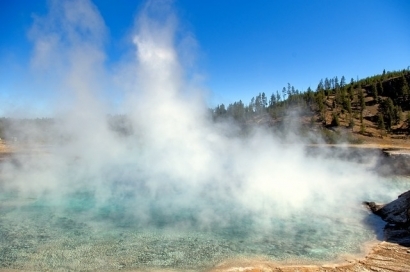
However, geothermal energy holds a unique advantage: it provides continuous, reliable, and carbon-free electricity, making it an indispensable component in the shift to sustainable energy.
Geothermal plant operators, and the energy sector more broadly, must consider the entire supply chain when searching for efficiency gains, and that starts with looking behind the scenes at the vital technology which powers the process.
Enabling a steady supply of energy
Geothermal energy offers a steady and predictable power supply from underground reservoirs of water heated by the earth’s crust. This ensures that geothermal can serve as a baseload power source, operating 24/7 and producing a constant supply for the grid, mitigating stability issues prevalent with other renewable energy sources while reducing dependence on fossil fuel-based backup systems.
Extracted by wells drilled several kilometers below the earth’s surface, steam from the reservoirs is directed towards turbines which turn and produce electricity. After passing through the turbine, the steam is cooled, condensed into water, and fed back into the ground to maintain the reservoirs.
However, these turbines are one part of a wider system of components which work together to generate power. Two essential pieces of equipment help to manage the motion involved – synchronous generators and induction motors. To ensure this process can operate continuously generators and motors need to be able to operate reliably under extreme conditions.
This requires solutions that enhance durability and reliability. Heat-resistant materials, corrosion-resistant coatings, and drive-controlled management systems protect generators and motors from high temperatures, corrosive minerals and gases, and surges in load.
Maximizing efficiency
Geothermal power generation requires optimized solutions to produce sustainable energy; with the right process and technologies geothermal can be one of the most efficient power sources in the current energy mix.
Heat rejection – the process of removing excess heat from the system – can result in wasted energy and account for up to one-third of a geothermal plant’s operational costs, yet it is a crucial part of the process.
Induction motors are key components in optimizing heat rejection and ensuring that geothermal plants run as efficiently as possible. Induction motors power cooling tower fans that dissipate heat from fluids after they pass through the turbines so they can then be reintroduced to the system or disposed of safely. Ensuring uninterrupted and efficient operation of these motors is essential for maintaining stable plant performance.
Induction motors with variable speed drives also play a significant role by keeping cooling systems running at top efficiency. This minimizes wasted energy and enhances overall plant performance. In addition, they play a vital role in circulating cooled water throughout the system.
Cooling systems are where the addition of variable frequency drives can have the most benefit. VFDs allow for precise pump/compressor control, moderating motor speeds dependent on real-time load conditions. This flexibility improves energy efficiency and reduces operational costs by lowering energy consumption, and also minimizes wear and tear, extending the lifespan of critical equipment.
Overcoming Challenges and Expanding Geothermal Adoption
However, geothermal energy faces barriers to widespread adoption, including high initial costs when building a new plant or expanding capacity. Prioritizing efficient technology when designing geothermal facilities lowers long-term costs, reducing the overall cost of ownership and operation. What’s more, combined motor and drive packages are not only more cost-effective and efficient to operate, they are also much easier to install and maintain throughout their lifespan.
Another challenge with geothermal power is grid integration. Grid stability is less of an issue than with other renewable energy sources, but there is still fluctuating output. This can be managed by synchronous condensers which are directly connected to the grid frequency and can provide significant inertia.
Conclusion
Geothermal energy is a reliable, sustainable power source that plays a vital role in the global energy transition. However, maximizing its potential requires technological advancements and the right infrastructure. Synchronous generators and induction motors are key to improving efficiency, managing heat rejection, and ensuring long-term durability. By investing in optimized equipment and intelligent control systems, geothermal power can become an even more significant contributor to a cleaner, greener energy future.
About the author: Luca Rizzo is Global Industry Manager at ABB Large Motors and Generators, developing and managing business opportunities throughout the world.

